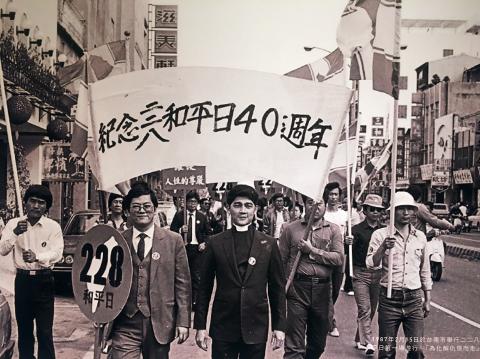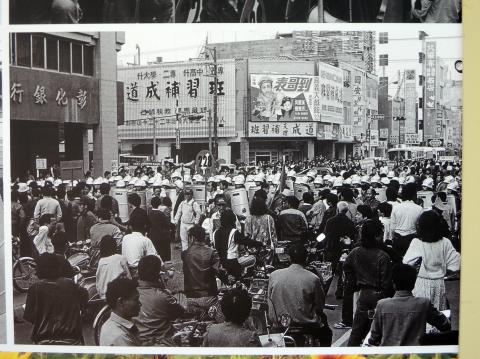Feb. 27 to March 5
“Today, the family of the victims will listen with their own ears as I, as a public servant of the country, accept the responsibilities of the government’s past mistakes and offer my deepest apologies.”
These words were part of the speech by then-president Lee Teng-hui (李登輝) on Feb. 28, 1995, the 48th anniversary of the anti-government uprising and subsequent brutal crackdown that would be known as the 228 Incident.

Photo: Hung Jui-chin, Taipei Times
It was the first time a president officially addressed the incident, much less apologized for it, as the incident had remained a taboo subject well into the 1980s. Even after the lifting of martial law, artist Chan San-yuan (詹三原) was reportedly jailed (under other pretenses) for designing Taiwan’s first 228 memorial monument in Chiayi in 1989.
CENSORING 228
To understand the extent the incident was “erased” from public memory, communications professor Hsia Chun-hsiang (夏春祥) analyzed news reports from the Taiwan Shin Sheng Daily News (台灣新生報), United Daily News (聯合報) and China Times (中國時報) between 1947 and 2000.

Photo: Hung Jui-chin, Taipei Times
Between 1948 and 1957, only four news articles mentioning the 228 Incident appeared in these papers, all of them appearing in the government-run Taiwan Shin Sheng Daily News. One of these detailed the punishments for those involved in the uprising, and the other three were direct reports on notable people involved with the incident.
After 1957, the 228 Incident disappeared from these papers for 27 years until the United Daily News published a feature on the history of the Central News Agency, which mentions how staff members reacted during the incident.
In 1985, legislator Chiang Peng-chien (江鵬堅) requested that the government acknowledge and apologize for the incident, suggesting that they designate Feb. 28 as “Peace Day.” The Executive Yuan did not respond and major newspapers did not report on the matter.
Two days before the 40th anniversary of the event in 1987, the first critical article appeared in the United Daily News, a column by historian Hsu Cho-yun (許倬雲) asking the government to directly address and resolve the “228 tragedy.”
Martial law was lifted a few months later, and freedom of speech began to return. By 1992, a United Daily News poll showed that 80 percent of respondees knew about the incident.
INTO THE SPOTLIGHT
Despite official censorship, Taiwanese kept the memory of the 228 Incident alive in private. And since the 1950s, independence activists working in Japan and the US continued to make the incident one of their talking points.
According to the article The Predicament of Historical Justice: Ethnic Issues and the Discourses on the 228 Uprising by historian Chen Tsui-lien (陳翠蓮), overseas Taiwanese published books in 1983 and 1984 that heavily criticized the KMT’s handling of the events.
The government dismissed these authors as instigators who were reopening old wounds to advance their independence agenda. They decided to write their own book, which contained the following passage:
“After the incident, the government and people both stopped talking about the events because of how painful it is to everyone …We only hope that time can wash away these horrific memories and people can stop debating which facts are true and who was in the wrong ... Otherwise it will only disturb our peaceful life as a united people. These overseas groups bring this event up each year to slander the government and distort the truth.”
In February 1987, local activists started the 228 Peace Day Association ( 二二八和平日促進會) and started holding memorials all over the country. Although riot police were sent to stop them, the activities continued. Chen writes that the government at this point finally realized that they could no longer brush the incident aside.
At first, officials continued the rhetoric of “needlessly reopening old wounds,” but after the end of martial law, more legislators spoke out and the media reports only continued to increase, although Chen writes that much of the content echoed that of the government.
When Lee became president in 1988, he too stated that people should bury the hatchet and look toward the future instead of the past. By 1990, his stance had changed, establishing a 228 Incident Task Force and allowing the events to be included into high school textbooks for the first time.
However, the family of the victims and 228 activists were not satisfied especially because their calls for the government to formally apologize were repeatedly denied.
After his 1995 apology, Lee added that this was just the beginning.
“We can’t be satisfied with building this monument,” he said. “We need to publicize the truth behind the events, compensate the victims, designate a memorial day, and also heal our people’s spirits and rebuild their dignity. These will all happen in the near future.”
Taiwan in Time, a column about Taiwan’s history that is published every Sunday, spotlights important or interesting events around the nation that have anniversaries this week.

The Taipei Times last week reported that the rising share of seniors in the population is reshaping the nation’s housing markets. According to data from the Ministry of the Interior, about 850,000 residences were occupied by elderly people in the first quarter, including 655,000 that housed only one resident. H&B Realty chief researcher Jessica Hsu (徐佳馨), quoted in the article, said that there is rising demand for elderly-friendly housing, including units with elevators, barrier-free layouts and proximity to healthcare services. Hsu and others cited in the article highlighted the changing family residential dynamics, as children no longer live with parents,

It is jarring how differently Taiwan’s politics is portrayed in the international press compared to the local Chinese-language press. Viewed from abroad, Taiwan is seen as a geopolitical hotspot, or “The Most Dangerous Place on Earth,” as the Economist once blazoned across their cover. Meanwhile, tasked with facing down those existential threats, Taiwan’s leaders are dying their hair pink. These include former president Tsai Ing-wen (蔡英文), Vice President Hsiao Bi-khim (蕭美琴) and Kaohsiung Mayor Chen Chi-mai (陳其邁), among others. They are demonstrating what big fans they are of South Korean K-pop sensations Blackpink ahead of their concerts this weekend in Kaohsiung.

Taiwan is one of the world’s greatest per-capita consumers of seafood. Whereas the average human is thought to eat around 20kg of seafood per year, each Taiwanese gets through 27kg to 35kg of ocean delicacies annually, depending on which source you find most credible. Given the ubiquity of dishes like oyster omelet (蚵仔煎) and milkfish soup (虱目魚湯), the higher estimate may well be correct. By global standards, let alone local consumption patterns, I’m not much of a seafood fan. It’s not just a matter of taste, although that’s part of it. What I’ve read about the environmental impact of the

Oct 20 to Oct 26 After a day of fighting, the Japanese Army’s Second Division was resting when a curious delegation of two Scotsmen and 19 Taiwanese approached their camp. It was Oct. 20, 1895, and the troops had reached Taiye Village (太爺庄) in today’s Hunei District (湖內), Kaohsiung, just 10km away from their final target of Tainan. Led by Presbyterian missionaries Thomas Barclay and Duncan Ferguson, the group informed the Japanese that resistance leader Liu Yung-fu (劉永福) had fled to China the previous night, leaving his Black Flag Army fighters behind and the city in chaos. On behalf of the